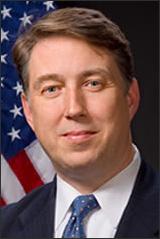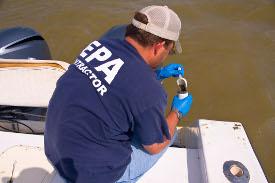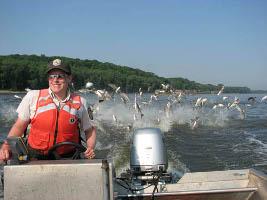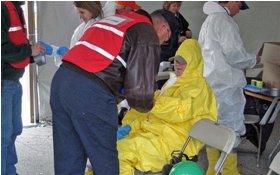EPA Science Matters Newsletter: Volume 1, Number 2
Published June / July 2010
Executive Message
- Executive Message: Thoughtful Design Versus Reaction

Seldom in all my years at EPA have I been more impressed by the raw effort and dedication of the people of EPA, and of course here in the Office of Research and Development, in response to the oil spill in the Gulf of Mexico.
Day in and day out I’ve been in the Emergency Operations Center where people come together to solve some of the most challenging questions the Agency has ever faced, and work to prevent a tragedy from becoming a catastrophe.
As I look around the table, I see scientists and engineers sitting down and intensely engaging with economists, attorneys, communication specialists, and community outreach experts. It is a truly integrated trans-disciplinary endeavor. It has made it even more clear to me than it had been before the importance of integrated trans-disciplinary systems thinking.
When we are faced by the type of emergency such as the tragedy in the Gulf, we recognize that it takes all talents to come together and focus like a laser.
What is also clearer to me than ever before is that it is the lack of this kind of integrated trans-disciplinary systems thinking up-front that often leads us as a society into these types of environmental crisis situations. Thoughtful sustainable design has the potential to minimize both the potential for these types of situations to occur and to minimize the consequences when accidents do happen. It is a classic example of invest a little now versus having to pay tremendously later.
How will our response to the tragedy unfolding in the Gulf of Mexico change how we approach EPA research, now and into the future? By incorporating integrated trans-disciplinary design into our scientific and technical support actions, our research products will be useful and informative to those seeking to make the products, processes, and systems of the future more sustainable and to those who are reacting to the next foreseeable yet unforeseen crisis.
Our colleagues are contributing to dealing with the situation in the Gulf — spending days, nights, and weekends. How I wish it were unnecessary for them to be working on such a terrible event. The hope remains that as we spend our efforts on thoughtful trans-disciplinary design through our research that there will be fewer of these tragedies in the future.
EPA Research Highlights
- Science to Support EPA’s Response to the BP Oil Spill
EPA scientists and engineers are supporting the coordinated response to the Deepwater Horizon oil spill.

The U.S. Environmental Protection Agency (EPA) has provided full support to the U.S. Coast Guard, the leader of the coordinated federal response to the BP oil spill in the Gulf of Mexico. EPA’s efforts are being informed and supported by EPA scientists and engineers from across the Agency.
EPA’s cadre of scientists are uniquely positioned to provide immediate and ongoing technical advice and expertise, as well as work to facilitate the gathering and analysis of data from air, water, waste and sediment samples from the affected area. In coordination with the Joint Incident Command, Agency scientists are communicating results and information to emergency responders, citizens, and others in need of the latest scientific information.
In addition, EPA researchers are laying the groundwork to provide both the near- and long-term scientific support needed for clean-up and research activities that are likely to be needed over the coming months and perhaps years.
One of EPA’s first scientific actions was deploying equipment and personnel to assess environmental conditions for potential water and air contamination. EPA researchers deployed the emergency response vehicles TAGA, a self-contained mobile laboratory capable of real-time air emission sampling and analysis, and ASPECT, a twin engine “flying laboratory” aircraft designed to assist in the collection of air sampling data as well as photo documentation of environmental incidents.

EPA researchers are developing sampling approaches and Quality Assurance plans to support reliable data collection to assess environmental exposure and effects of the oil spill over the next several months. The Agency will continue to identify and evaluate likely exposure pathways for the oil, dispersed oil, and dispersant to reach humans and ecological receptors (such as plankton, fish, wildlife, and coastal vegetation).
Tragically, the environmental effects of the oil spill will almost certainly have far-reaching and long-term effects. Based on their ongoing work to support immediate and near-term remediation efforts, EPA researchers have begun designing sampling and analysis plans that can support long-term assessments of the incident, as well as the efficacy of the remediation and the recovery of the area.
Researchers and engineers from across EPA will continue to provide the needed scientific and technical support the Agency needs to respond to the tragic Deepwater Horizon Oil spill.
Environmental data, including air quality and water samples, is updated daily on EPA’s BP Oil Spill Response Web site as it is collected and validated by EPA’s response teams along the impacted coastlines. This data is meant to determine potential risks to public health and the environment.
Following the BP Oil Spill in the Gulf of Mexico on April 22, 2010, EPA has provided full support to the U.S. Coast Guard and continues to closely coordinate with other federal, state and local agencies to monitor and respond to potential public health and environmental concerns.
- Hydraulic Fracturing: Drilling for Answers
EPA researchers will study key aspects of the potential environmental and human health impacts of a technique used to drill for natural gas.
 Hugh Bases began camping with his dad and brothers on his uncle’s farm, a patchwork of pastureland, open meadows, and forest in the Catskill region of New York, when he was a toddler some 40 years ago. Now a developmental pediatrician and a dad himself, he enjoys bringing his young daughter and son to the farm to cookout, splash around in the pond, and camp under the stars.
Hugh Bases began camping with his dad and brothers on his uncle’s farm, a patchwork of pastureland, open meadows, and forest in the Catskill region of New York, when he was a toddler some 40 years ago. Now a developmental pediatrician and a dad himself, he enjoys bringing his young daughter and son to the farm to cookout, splash around in the pond, and camp under the stars.Recently, Dr. Bases has started to wonder if the farmland that has been in his family for going on three generations might be sitting on top of a lucrative natural gas reserve, making it far more valuable for the resource below than for the grass and space leased to a local dairy farmer.
“My ears really perked up when I began to hear that energy companies might be interested in leasing land in the area for natural gas development,” says Dr. Bases. “But I also know the area is part of New York City’s watershed, so I wondered if it was going to be allowed, or even appropriate.”
The farm is one of many properties in an area stretching from New York to Tennessee that are sitting above a subterranean geologic formation known as the Marcellus Shale. Geologists estimate that locked within the sedimentary rock some 6,000 to 8,000 feet below is one of the world’s biggest natural gas fields, containing enough energy to meet the natural gas needs of the entire United States for two full years.
A convergence of factors over the past few years have put the Marcellus shale and other areas once considered too deep or otherwise economically unfeasible into play for natural gas development. Rising energy prices, the need to expand domestic energy supplies, and an economic downturn that has hit rural areas particularly hard, have combined to spark a potential natural gas boom. What’s more, natural gas burns cleaner and emits less greenhouse gas per unit of energy than other fossil fuels.
With those factors already in place, a drilling technique known as hydraulic fracturing—“fracking” for short—has made it both possible and profitable to unlock natural gas reserves from deep, rocky geologic formations, such as the Marcellus shale, found in many areas of the country.
The key component of hydraulic fracturing, and what gives the technique its name, is creating or enlarging cracks in subterranean rock formations. Drill shafts are sent deep into the ground. Then, large quantities of water (millions of gallons per well), along with chemicals and “proppants” (sand, ceramic beads, or other small particles that hold open the cracks) are injected into the shaft at high pressure, cracking open fissures into rock. The proppant holds the fissures open, allowing the natural gas to flow into the well shaft where it can flow up to the surface.
Drilling, together with injecting water, sand, and chemicals has provided a technological solution to the challenge of harvesting natural gas from deep underground rock formations.
But the practice of hydraulic fracturing has raised questions about its potential impact on the environment and human health, particularly on water quality and drinking water:
- What impact does removing the large amounts of water needed for high-pressure drilling have on a watersheds and aquifers?
- What are the potential impacts of the chemicals and drilling muds used in drilling and the hydrofracturing process, wastewater, and fractured geology have on water quality and underground drinking water supplies?
At the request of the Congress, researchers at the U.S. EPA are gearing up to provide the science needed to answer these and other questions related to hydraulic fracturing.
“Our research will be designed to answer questions about the potential impact of hydraulic fracturing on human health and the environment,” said Paul T. Anastas, Ph.D, the Assistant Administrator for EPA’s Office of Research and Development. “The study will be conducted through a transparent, peer-reviewed process, with significant stakeholder input.”
Still in the early stages of developing a strategic research plan, EPA scientists, engineers, and science policy experts are working together to define the most pertinent research questions, identify gaps in existing data, build a robust process to incorporate stakeholder input, and identify research priorities.
Once a detailed study design is developed it will undergo external scientific peer review before research activities are implemented.
EPA’s Office of Research and Development produced Scoping Materials for Initial Design of EPA Research Study on Potential Relationships Between Hydraulic Fracturing and Drinking Water Resources, a document to elicit ideas and suggestions from the EPA Science Advisory Board (SAB). The SAB is an independent, external federal advisory committee called upon to provide expert council to the Agency regarding technical matters.
The SAB has been working to advise EPA on the scope of a hydraulic fracturing study, identify key research questions, and provide input for making stakeholder involvement an integral component of the research program.
Once the SAB’s recommendations are incorporated together with input from stakeholders, the Office of Research and Development will conduct key studies focused on high priority research questions. It is anticipated that research will begin during 2011, with initial outcomes and research products available by the end of 2012.
- Climate Change and Aquatic Invasive Species
U.S. EPA researchers are helping states incorporate the effects of climate change into plans to manage aquatic invasive species in their waters, coasts, and wetlands by looking at the combined effects of climate change and these organisms.

A number of sport anglers plying the Illinois River have put down their fishing rods in favor of bows and arrows. They’ve found better luck snaring their quarry out of the air than with the traditional baited-hook method.
What the anglers are aiming for is silver carp (Hypophthalmichthys molitrix). Native to Asia, these heavy-set fish can grow to four feet in length and weigh well over 70 pounds.
But it’s not all fun and games.
The carps’ habit of leaping out of the water when they sense a boat engine approaching occasionally brings these big fish directly into the pathway of the oncoming vessel. Collisions with airborne carp have resulted in broken jaws, concussions, loose teeth, and other painful and potentially serious injuries.
Silver and bighead carp join a long list of species—including the zebra mussel (Drernia crassipes), Chinese mitten crab (Eriocheir sinensis), water hyacinth (Eichhornia crassipes), Northern snakehead (Channa argus), nutria (Myocastor coypus), and others—that scientists and environmental managers are working to better understand so they can take action to prevent, control, or eradicate them in order to protect native species, and both environmental and economic interests.
Those efforts may become more challenging as climate change adds a new dynamic to the equation. Researchers at the U.S. Environmental Protection Agency (EPA) are helping states and other partners meet those challenges.
EPA scientists recently released Climate Change and Aquatic Invasive Species and Implications for Management and Research, a comprehensive report on the interaction of climate change and aquatic invasive species. The report provides ecological managers with new insight into how to effectively deal with aquatic invasive species.
“The report evaluates the combined effects of climate change and aquatic invasive species on aquatic ecosystem structure and function, and suggests potential paths forward that will increase understanding and improve management,” explains Dr. Michael Slimak, an EPA ecologist who helps lead invasive species research at the Agency.
A state-of-the-science assessment of the potential for climate change to affect aquatic invasive species provides managers and researchers with an important reference for incorporating climate change into their action strategies. The report also presents an analysis of existing management plans that identifies the capacity of each state to modify or adapt activities to account for climate-change effects.
The report is one of the first comprehensive efforts to present information incorporating what is known about the interactions of two complex environmental challenges: climate change and invasive species. While it provides a valuable reference, it also identifies the need for continued scientific research in order to provide the information and tools needed to effectively identify, prevent, contain, and when necessary, eradicate aquatic invasive species.
EPA researchers will continue to lead the effort to provide the science needed to bridge that gap.
Editor’s Note: A version of this article appears in the EPA Research Highlights column in EM Magazine, a publication of the Air and Waste Management Association.
- When Students Compete for Sustainability, Everybody Wins!
Student engineers and scientists competed for Best Sustainable Design at the Annual National Sustainable Design Expo.

On April 24 and 25, 2010, 42 teams of budding scientists and engineers from colleges and graduate schools from across the country gathered on the National Mall in Washington, DC at the Sixth Annual National Sustainable Design Expo to showcase their innovative designs for advancing environmental sustainability.
The teams competed for the U.S. Environmental Protection Agency’s coveted P3 Award for sustainability.
The three “P’s” in P3 stand for People, Prosperity, and the Planet. Established in 2004, the competition is focused on supporting innovative designs that benefit people, promote prosperity, and protect the planet while advancing sustainability in both the developed and developing world.
By specifically tapping the creative energy of undergraduate and graduate student design and research teams, the competition serves as a catalyst for sustainability education in the nation's colleges and universities.
The competition has two phases. In phase I, student teams and their faculty advisors submit research proposals for a chance to earn up to $10,000 in seed money to research and develop their design projects during the academic year.
All phase I grantees are invited to the National Mall in Washington, DC each spring to present their projects at the National Sustainable Design Expo. Each design is reviewed by a panel of judges convened by the American Association for the Advancement of Science (AAAS). The panel's evaluations are passed on to EPA officials, who then award the prestigious EPA P3 Award.
The P3 Award brings with it the opportunity to receive up to $75,000 in additional grant money for the students to use to advance their designs from the prototype phase to the marketplace.
Four winning teams from past years have turned their winning ideas into successful small businesses.
The 2010 P3 Award winners were announced on April 26 during a ceremony in Washington, DC. "Sustainable innovations like the ones created by our P3 Award winners are the environmental and economic future of our nation. In fields from agriculture to architecture to energy production, sustainability is the true north on the path ahead," said Paul T. Anastas, Assistant Administrator for the EPA's Office of Research and Development.
The winning 2010 P3 teams and their winning sustainable designs are:-
Appalachian State University
Biomass Gasification for Agricultural Energy Sources and Soil Enrichment -
Clarkson University
Farm Waste to Energy: A Sustainable Solution for Small-Scale Farms -
Clarkson University
Sustainable Year-Round Food Production in Cold Climates -
Clemson University
SEED: Emergent Container Housing Initiative – Solutions for the Caribbean -
Cornell University
Dose Controller for AguaClara Water Treatment Plants -
Drexel University
Alkali-Activated Slag Cement (AASC) as a Sustainable Building Material -
Humboldt State University
Smoothing the Peaks: Smart Outlets to Reduce Brownouts on Micro-Hydroelectric Mini-Grids in Bhutan -
North Carolina Agricultural and Technical State University
Enhancing Urban Sustainability through the Application of Permaculture Principles -
Roger Williams University
Development Alternative Power to Drive a Partitioned Aquaculture System for Intensive Food Fish Production -
Texas A&M University
Horizontal Hybrid Solar Light Pipe: an Integrated System of Daylight and Electric Light -
University of Illinois at Urbana-Champaign
Virus Removal in Slow-Sand Filters for Rural Mayan Communities -
University of North Carolina at Chapel Hill
Evaluation of Chitosan Coagulation as a Sustainable Method for Point of Use Drinking Water Treatment in Developing Countries -
Virginia Polytechnic Institute and State University (Virginia Tech)
A Sustainable Approach to Nitrate Reduction Combining a Riparian Zone with a Stream Denitrifying Biofilm -
Wellesley College, Harvard University, Massachusetts Institute of Technology, and Qinghai Normal University
A Comprehensive Platform for Rural Energy Optimization in the Himalayan Region
-
- Liberty RadEx Drill Helps Nation Prepare for ‘Dirty Bomb’ Scenario
EPA scientists helped plan and support major simulation of testing, clean up, and recovery phases following a deliberate radiation attack.

On the night of May 1, 2010, a crude car bomb rigged from gasoline, firecrackers, and alarm clocks was discovered smoldering in the heart of New York City’s Times Square. Fortunately, the bomb never exploded. Instead of mass casualties, the failed terrorist attack provided another chilling example of the critical need for continued vigilance in homeland security activities.
Not more than three weeks before the failed car bomb, experts from the U.S. Environmental Protection Agency (EPA) led an extensive training exercise for responding to a terrorist attack. Officials from a host of different government agencies and private companies prepared for the detonation of a “dirty bomb” containing radiological materials. Such an event would lead to widespread contamination, disruption, and fear.
Sponsored and designed by EPA, “The National Tier 2 Full-Scale Radiological Dispersion Devise Exercise”—named Liberty RadEx— was a national drill to practice and test federal, state, and local assessment and clean up capabilities in the aftermath of a dirty bomb, “a radiological dispersion device incident,” in an urban environment.
Various Presidential Directives following the terrorist attacks of September 11, 2001 and the subsequent issuance of the National Response Framework confirmed EPA’s historic and regulatory role as the federal agency responsible for leading the assessment, mitigation, and cleanup of hazardous materials, including weapons of mass destruction, following a terrorist attack.
The Agency established a homeland security research program to develop and deliver reliable, responsive expertise and products based on scientific research and technology evaluations for hazardous materials and for EPA’s drinking water protection responsibilities.
EPA scientists and engineers were intimately involved in the planning and execution of the Liberty RadEx drill to ensure that the latest research and technology would be available to all participants. For more than a year, EPA researchers participated in multi-agency workgroups to help define the critical, long term issues that would have to be addressed during the aftermath of a dirty bomb explosion.
“In the aftermath of a dirty bomb attack, it is critically important for local officials and communities to have access to the best available science and expertise,” explains Bill Steuteville, EPA Region 3 Homeland Security Coordinator and one of the Exercise Directors for Liberty RadEx. “EPA has such expertise and capabilities and is one of the lead federal agencies working on homeland security research. Liberty RadEx was a great opportunity to work with our state and local partners to demonstrate EPA’s capabilities and the latest detection and clean-up technologies in order to protect the public and help the community efficiently and effectively.”
The scenario in the Liberty RadEx exercise was built around the likely aftermath of a suicide attack launched from a van loaded with 3,000 pounds of ammonium nitrate mixed with diesel fuel and radioactive Cesium-137.
 EPA’s Emily Snyder suits up for Liberty RadEx exercises.
EPA’s Emily Snyder suits up for Liberty RadEx exercises.More than 1,000 participants, representing federal, state, and local agencies, as well as private citizens and companies, were involved. Field drills and training exercises took place April 27 to 29, 2010 in and around Philadelphia, PA.
During the Liberty RadEx exercise, EPA scientists and engineers served as “controllers,” providing expertise and technical support. They also helped challenge participants by adding scientifically-based complexities known as “injects” (such as sudden changes in the situation or the discovery of new information) to the simulations and exercises, creating better learning experiences based on the risks and challenges that might unfold during a real radiological event.
The drill provided a real-world opportunity to apply and demonstrate clean-up technologies that had previously been tested primarily in EPA’s research laboratories. During the drill, participants were able to apply one such technology, Stripable Coatings for Radioactively Contaminated Surfaces, in both a subway station and the Philadelphia Fire Department Training Academy’s building.
EPA researchers and their partners used Liberty RadEx events to further develop and test a new tool that superimposes contaminant plume maps over Geographical Information System data to estimate the quantities and activity levels of contaminated waste and debris, including buildings, asphalt, and soil. Officials in charge of clean-up and decontamination activities applied these estimates to evaluate trade-offs between decontamination and disposal.
While most training exercises to date have focused on crisis response in the immediate aftermath of a terrorist attack, EPA researchers helped design Liberty RadEx to provide the first major exercise for developing and practicing the critical steps that must take place in the days and weeks after the initial response.
“This exercise was significant because it will help inform how all levels of government, business and community organizations can work together to meet challenges associated with long-term cleanup and community recovery from a dirty bomb attack,” said EPA Regional Administrator Shawn M. Garvin.
- Trees and Air Pollution
EPA modelers show how controlling man-made sources of air pollution may also reduce air pollution formed from compounds released from vegetation.

EPA researchers have discovered that controlling man-made sources of air pollution will have the added benefit of also reducing air pollution formed from compounds released from trees and plants.
Trees and plants release more than just oxygen into the atmosphere as a result of photosynthesis. They also release a variety of gases that contribute to air pollution. In fact, the planet’s vegetation accounts for about two-thirds of the pollutants known as volatile organic compounds (VOCs) emitted globally.
In the study, published in the May issue of Environmental Science & Technology, EPA researchers quantified for the first time how emissions from vehicles, industry and power plants interact with natural emissions from vegetation to change the composition and make-up of chemicals in the air…for the worse.
The implications of the study are considerable. “If we can control the man-made sources of emissions, we can indirectly affect the formation of these naturally derived atmospheric pollutant particles,” says Dan Costa, National Program Director for Clean Air Research at EPA.
Using computerized air quality modeling, investigators conducted simulations of natural and human-related pollution in the United States. When scientists took man-made pollutants out of the simulation, there was a 50 percent drop in pollutants from trees and plants in the Eastern United States. These pollutants, known as secondary organic aerosols (SOAs), are produced by sunlight when VOCs from trees, plants, cars or industrial emissions interact with other airborne chemicals. SOAs are important for the formation of two regulated air pollutants, particulate matter and nitrogen oxide, a greenhouse gas.“This study suggests that roughly half of the 'natural' SOA in the eastern U.S. forms only when there is enough man-made pollution around to form it,” says EPA scientist and lead author Annmarie Carlton.
“This model can guide us in developing strategies that can control our atmospheric chemistry,” says Costa. Over the last 40 years, similar EPA research efforts to develop a better understanding of clean air science have led directly to policies widely credited with better air quality, which in turn reduces hospitalizations, worsening levels of asthma, cardiac events and even deaths.
The research can also guide EPA to develop more refined and focused regulations and strategies for decreasing pollution effectively and efficiently. “This is just a first step in gaining an understanding of the complexity of the atmosphere such that we might intervene,” says Costa.
The research may also have implications for future air pollution management strategies as well. Scientists predict climate change will stimulate the growth of trees and plants and extend growing seasons, resulting in even more emissions from natural sources. By controlling man-made emissions, the impact of emissions from trees and plants may be reduced.
Citation
Carlton, A.G., R.W. Pinder, P.V. Bhave and G.A. Pouliot. "To What Extent Can Biogenic SOA be Controlled?", Environmental Science & Technology 44:3376-3380 (2010).
